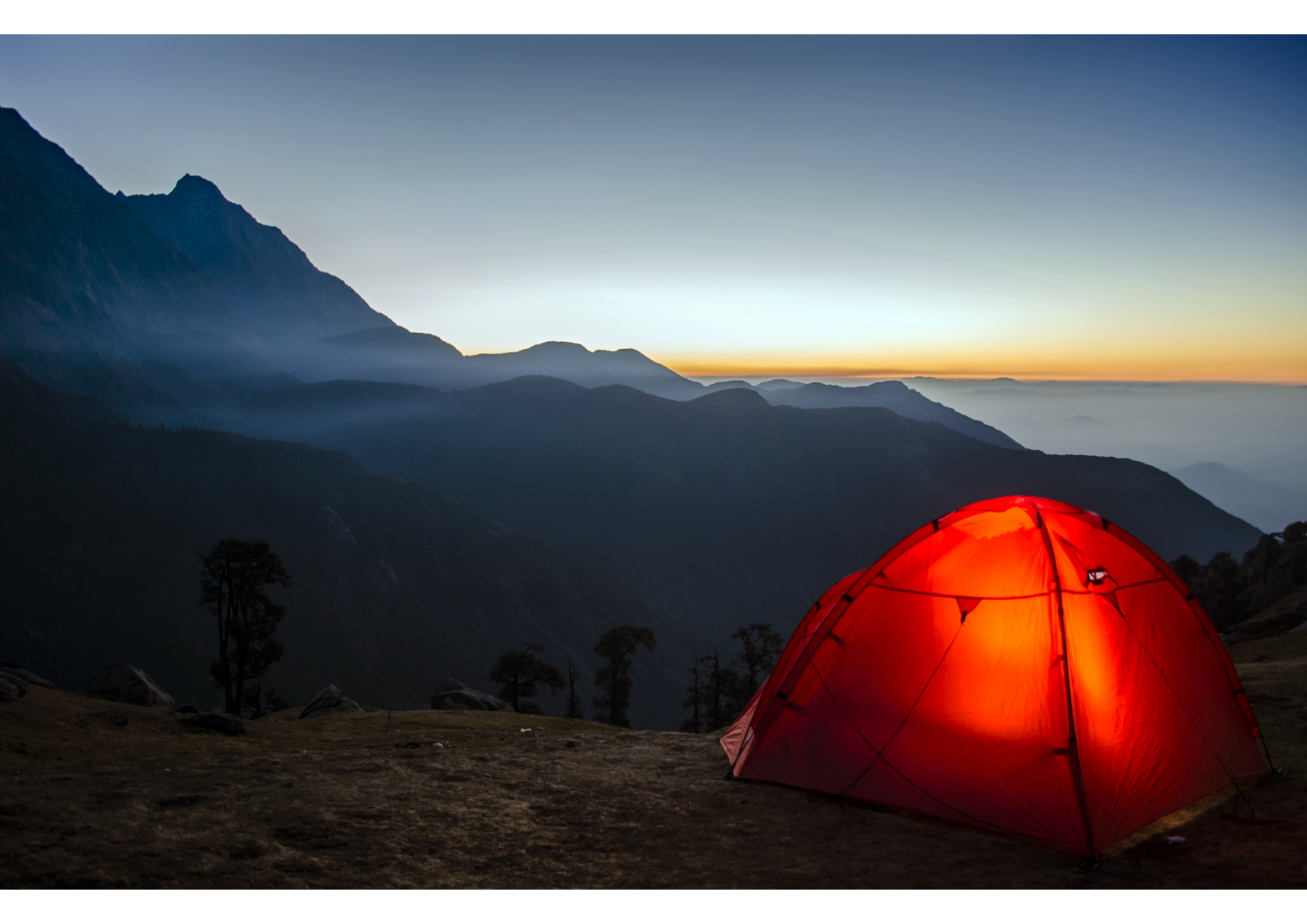If you’re reading this then you’re probably just about ready to embark on your first wild camping experience. You’ve probably checked the legal guidance on wild camping in the UK, researched and sorted all the equipment you’ll need and now it’s time to head out into the wild. But, how do you find the perfect pitch, what are the do’s and don'ts of wild camping and how can you keep yourself safe when you’re out there alone on the mountain side? For the final instalment of my Beginner Wild Camping Series, I’ve put together this guide that will answer all those questions and will hopefully give you the confidence you need to get out there and enjoy your wild camping experience.
Choosing the perfect pitch for wild camping
Choosing the perfect pitch for wild camping will definitely be made easier with a bit of map reading knowledge. You can of course take inspiration from where others have wild camped on social media and blogs. However, you might find that responsible wild campers are highly unlikely to give away their locations and instead encourage you to find your own. That’s why if you have a map of the area you’re thinking of wild camping in, you’ll be able to locate flat spots, water sources if needed and public footpaths or rights of way.
What to look for in the perfect wild camping pitch
When looking for the perfect pitch for wild camping you’ll probably want to consider these points;
- The location - it should be hidden and discreet. So, away from roads, footpaths and hidden from where people can see you.
- Is the ground flat- you don’t want to be rolling to either side or the end of your tent in the night. Choosing a flat site will make it much easier to pitch your tent and will give you a much more comfortable night’s sleep
- Do you need a water source? Unless you’ve carried up all the water you’ll need then you probably want to find a spot next to some form of water source like a lake or river
- Is it a sheltered spot? You don't want to be trying to sleep through winds buffeting your tent or trying to pitch or take your tent down in windy conditions
How to find the perfect wild camping pitch
The best way to find the perfect wild camping pitch is to be observant. Next time you’re out on a hike in a place you’d love to camp, keep an eye out for potential pitches. I like to pin locations on my phone onto Google Maps then I can research them when I’m home using Google satellite view and on OS maps.
If you aren’t planning on heading out for a hike to do some pre-checks, then this is where map reading comes in handy. You don’t need to be able to read a map fully to be able to find a wild camping spot but the tips below will definitely come in handy.
Using OS maps to find the perfect wild camping pitch
Using OS (Ordnance Survey) map legends - imagine this to be like a little key that tells you what things are on a map. It will show you where footpaths are, how steep the land is and where water sources are as well as much more.
I would always recommend having a paper OS map to hand but if you don’t then you can use Bing’s mapping service with the free OS layer to scour the area you’re thinking of wild camping in. If we take a look at an area in the Lake District using that mapping service, we can see a possible wild camping spot next to a small tarn in the mountains.

I’d then cross-reference this with the satellite view and we can spot some potential wild camping spots around the tarn.

Of course, they aren’t guaranteed so if you’re heading somewhere unknown for your wild camp, you need to be ready for plans to change without warning or to be faced with something different from what you expected.
In the UK, you’re also expected to follow a few simple rules when wild camping. These include;
- Choosing a remote location away from built-up areas and private dwellings
- Outside of Scotland, camping above the highest boundary wall such as a farm wall
- Pitch your tent late (just before sunset) and leave early (just after sunrise)
- Keep group sizes small (this isn’t an opportunity for you and ten of your mates to live it up in the mountains)
- Avoid sensitive areas such as wildlife hotspots, nature reserves, farmlands, SSSI (Sites of Special Scientific Interest) areas
Wild camping responsibly
If you’ve read up on the legalities to wild camping in the UK, then you’ll know that in most parts of the UK, it’s illegal without prior consent from the landowners. This excludes Scotland where they have the Right to Roam but this still doesn’t mean you can wild camp wherever you like. Wild camping, as long as you do it responsibly and respectfully, is often allowed. Therefore, it’s important that if you go wild camping, to always follow the Leave No Trace principle, to ensure we can enjoy wild camping for many years to come.
What is the Leave No Trace principle?
The Leave No Trace principle is a set of ethics that are designed to promote the conservation of the outdoors.It originally came from the United States in the 1960s as a response to increasing environmental damage thanks to outdoor activities such as wild camping. Wild camping has really taken off in the UK lately and unfortunately, this has resulted in our beautiful outdoors being trashed, destroyed and treated in the most unforgiving ways. Just take a look at this article from the BBC to see how bad it has been lately;
Unfortunately, this isn’t an unusual occurrence with people littering, cutting down trees and leaving all their equipment, assuming others will tidy up after them. Rangers in our National Parks are not paid to tidy this mess up and this type of camping doesn’t follow the clear guidelines mentioned earlier.
The Leave No Trace principles are simple; wherever you go, there should be no trace that you have been there.
How does the Leave No Trace principle apply to wild camping?
Unlike in some countries, where wild camping is more regulated, many parts of the UK operate on a trust-based system that assumes campers will act responsibly. By leaving no trace, we can help maintain the balance between enjoying the freedom of the outdoors and preserving nature. After spending a night out in the wild, there should be no sign you were ever there which means;
- Taking all your rubbish and equipment home with you - don’t leave wrappers, leftover food or peels, toilet roll, or your tent that didn’t withstand the rain. Take it ALL home with you.
- Human waste - don’t leave it for everyone to see. Either dig a deep hole and bury it or better yet, pack it out with you in a sealable tube. Toilet roll should either be burned or again, packed out with you because if you bury it, animals will dig it up. You may think it sounds disgusting packing it out or burying it BUT, imagine how you would feel if you stepped in another human’s waste.
- No fires on the ground - don’t leave behind scorch marks or ash
- Arrive late and leave early
- Keep noise down
- Don’t disturb the natural environment - no cutting down trees and don’t camp in areas of flowers or try pulling up shrubs or moving rocks to make way for your tent
- If you are asked to move on by the landowner or someone representing them, then move
Safety advice for wild camping
Wild camping, especially on your own, can feel like a scary thing to do but you're probably more safe than you think you are out in the mountains. If you don't feel like you can take the step to wild camping solo in the mountains just yet, then head for a campsite solo first, so that you know what it feels like to do it all alone.
Ensuring your safety is important when wild camping so here's some top tips for any wild campers, solo or not;
- Always research your chosen location thoroughly—understanding the terrain, weather conditions, and local wildlife will help you prepare accordingly
- Tell someone you trust about your plans, including your intended camping spot and expected return time. Then remember to keep them posted about any changes if you have signal and let them know when you get back to your car the next day
- Have some navigation skills and understanding of a map and route finding so you can navigate off the mountain if needed and to help find an alternative camp spot if your first one isn’t suitable
- Make sure you have a first aid kit and enough food and warm clothes - I really recommend the Rambler Fleece to keep you cosy at night.
- Have a fully charged mobile phone and power bank
For solo female campers, extra precautions can offer more peace of mind. Choosing a discreet camping spot, away from paths or roads, reduces the chance of unwanted encounters. Setting up camp late and leaving early can help maintain a low profile. Trust your instincts—if a location doesn’t feel right, it’s okay to move on. I even read about someone who used a tiny carabiner clip between her zips on her tent so that her tent couldn’t be unzipped from the outside while she was in it.
I hope this was useful and will help you plan your first wild camping trip. If you had out on your first one after reading this, please do let us know as we love to hear about your adventures! Remember to check out some of my other blogs here on the My Urban Trail website or follow me on Instagram.
Happy wild camping!
Izzy x





